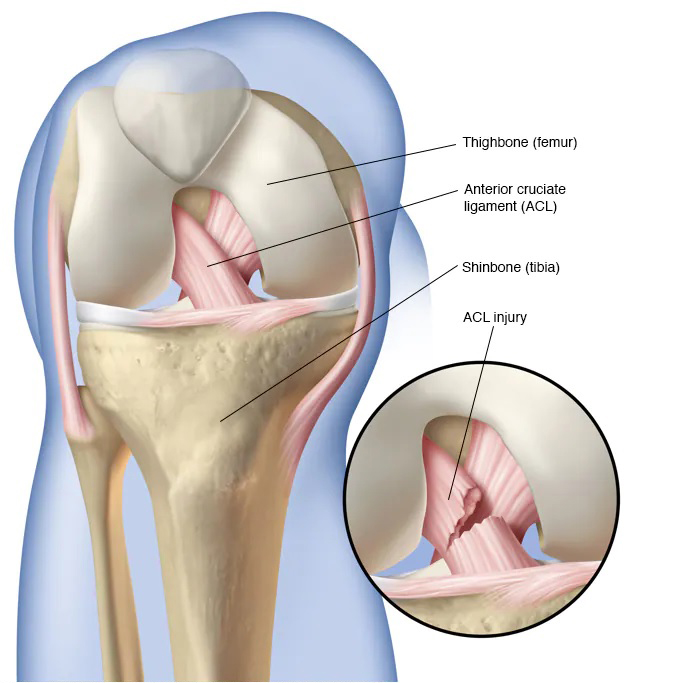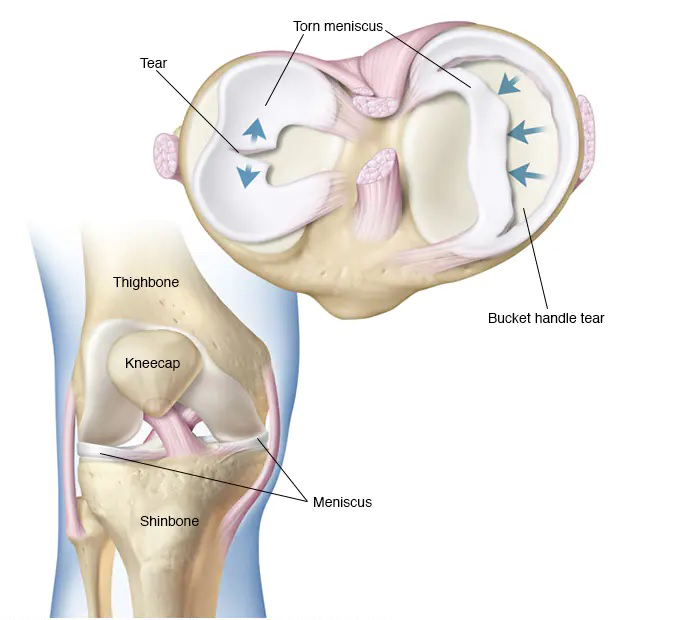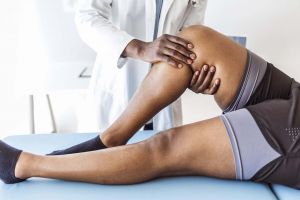Knee Pain
Knee Pain
What you need to know about Knee Pain
Knee pain affects people of all ages and is a frequent problem. An injury to the knee, such as a burst ligament or torn cartilage, can cause pain. Knee discomfort can also be caused by medical disorders such as arthritis, gout, and infections.
Self-care strategies work well for many types of minor knee pain. Knee braces and physical therapy might also help reduce pain. However, your knee may require surgical surgery in some circumstances.
Symptoms of Knee Pain
Depending on the origin of the condition, the location and degree of knee pain may vary. The following are some of the signs and symptoms that can occur when you have knee pain:
- Swelling and stiffness
- Redness and warm when touched
- Instability or weakness
- Noises of popping or crunching
- Knee not being able to fully straighten
Diagnosis
During the physical examination, your doctor is likely to undertake the following:
- Swelling, soreness, tenderness, warmth, and apparent bruises should all be checked on your knee.
- Examine how far your lower leg can be moved in various directions.
- Push or tug on the joint to assess the structural integrity of your knee.
Imaging tests
In some circumstances, your doctor may recommend testing like:
- X-ray. An X-ray, which can detect bone fractures and degenerative joint disease, may be recommended first by your doctor.
- A CT scan. A type of computerised tomography. CT scanners create cross-sectional images of the inside of your body by combining X-rays acquired from a variety of angles. CT scans can be used to detect bone abnormalities and minor fractures. Even if the joint isn’t inflamed, a unique type of CT scan can reliably detect gout.
- Ultrasound. Sound waves are used to create real-time images of the soft tissue structures within and around your knee with this technique. During the ultrasound, your doctor may want to move your knee into various positions to look for specific concerns.
- Magnetic resonance imaging (MRI). An MRI creates 3D images of the interior of your knee using radio waves and a powerful magnet. This test is very beneficial for detecting soft tissue injuries such as ligaments, tendons, cartilage, and muscles.
Lab tests
If a doctor suspects an infection or inflammation, they may order blood tests and possibly an arthrocentesis. A procedure will be performed in which a small amount of fluid is removed from within your knee joint with a needle and sent to a laboratory for analysis.
Causes
Injuries
-
Injury of the ACL. An anterior cruciate ligament (ACL) injury is a tear in one of the four ligaments that connect your shinbone to your thighbone. People who play basketball, soccer, or other activities that require abrupt changes in direction are more likely to sustain ACL damage.

-
Fractures. During falls or car accidents, the bones of the knee, including the kneecap (patella), can be fractured. In addition, patients with osteoporosis might sometimes sustain a knee fracture simply by taking an incorrect step.
-
Bursitis of the knee. Some knee injuries induce inflammation in the bursae, which are tiny fluid sacs that cushion the outside of the knee joint and allow tendons and ligaments to glide over it easily.
-
Patellar tendonitis. A condition that affects the patellar tendon. Tendonitis is a condition in which one or more tendons; the thick, fibrous fibres that connect muscles to bones become irritated and inflamed. An injury to the patellar tendon, which runs from the kneecap (patella) to the shinbone and allows you to kick, run, and leap, can cause inflammation. Patellar tendonitis can affect runners, skiers, cyclists, and others who participate in jumping sports and hobbies.
-
Torn meniscus. The meniscus is thick, rubbery cartilage that sits between your shinbone and thighbone and works as a stress absorber. If you suddenly twist your knee while bearing weight on it, it can tear.

Mechanical problems
The following are some examples of mechanical issues that might cause knee pain:
- Loose body. A fragment of bone or cartilage might break off and float in the joint space due to injury or deterioration of the bone or cartilage. Unless the loose body interferes with knee joint mobility, in which case the effect is similar to a pencil trapped in a door hinge, this may not cause any problems.
- Iliotibial band syndrome. This happens when the iliotibial band (a tough band of tissue that runs from the outside of your hip to the outside of your knee) becomes so tight that it rubs against the outside of your thighbone. Illiotibial band syndrome is more common in distance runners and bikers.
- Dislocated kneecap. This happens when the patella, the triangular bone that covers the front of your knee, slips out of place, usually to the outside. The kneecap may remain dislocated in some situations, and the dislocation will be visible.
- Hip or foot pain. If you experience hip or foot pain, you may want to alter your walking style to relieve the pressure on your problematic joint. However, this altered walk can put greater strain on your knee joint, resulting in knee pain.
Types of arthritis
There are over 100 different forms of arthritis. The following are the kind that is most likely to impact the knee:
- Osteoarthritis. Osteoarthritis, often known as degenerative arthritis, is the most frequent type of arthritis. It’s a wear-and-tear condition in which the cartilage in your knee deteriorates as a result of use and age.
- Rheumatoid arthritis. A type of arthritis that affects the joints. Rheumatoid arthritis, the most devastating kind of arthritis, is an autoimmune disease that can damage practically any joint in your body, including your knees. Although rheumatoid arthritis is a chronic condition, its severity varies and it can come and go.
- Gout. Uric acid crystals form in the joints, causing this type of arthritis. Gout is most usually associated with the big toe, although it can also affect the knee.
- Pseudogout. Pseudogout is caused by calcium-containing crystals that form in the joint fluid and is frequently mistaken for gout. The most common joint afflicted by pseudogout is the knee.
- Septic arthritis is a type of arthritis that is caused by bacteria. Swelling, discomfort, and redness can occur when your knee joint becomes infected. Septic arthritis is characterised by a fever and the absence of trauma prior to the onset of pain. Septic arthritis can swiftly destroy the cartilage in the knees. See your doctor straight away if you experience knee pain and any of the signs of septic arthritis.
Other Problems
The phrase “patellofemoral pain syndrome” refers to pain that originates between the kneecap and the underlying thighbone. It’s frequent in athletes, young adults, especially those whose kneecaps don’t track well in their grooves, and elderly adults, who usually get it as a result of kneecap arthritis.
Complications
When to call a doctor
If you’re experiencing any of the following symptoms, contact your doctor:
- You can’t put any weight on your knee and it feels unstable or gives out.
- Your knee is significantly swollen.
- You can’t fully extend or flex your knee.
- You have a visible abnormality in your leg or knee.
- In addition to redness, discomfort, and swelling in your knee, you have a temperature.
- Have severe knee pain as a result of an injury.
Treatment
Treatment options will differ based on the cause of your knee discomfort.
Medications
Your doctor may recommend medications to reduce pain and address the underlying problems that are causing your knee pain, such as rheumatoid arthritis or gout.
Therapy
It will be more stable if you strengthen the muscles around your knee. Depending on the cause of your discomfort, your doctor may recommend physical therapy or different forms of strengthening activities.
If you are physically active or participate in sports, you may require workouts to correct movement patterns that are harming your knees and to create proper technique while participating in your sport or activity. Exercises that enhance flexibility and balance are also beneficial.
Arch supports, which may include wedges on one side of the heel, might assist redistribute pressure away from the osteoarthritis-affected knee. Different types of braces may be used to protect and support the knee joint in particular circumstances.
Injections
Your doctor may recommend injecting medicines or other things directly into your joint in some circumstances. Here are several examples:
- Corticosteroids. Corticosteroid injections into your knee joint may help lessen the symptoms of an arthritis flare and provide pain relief for a few months. These injections aren’t always effective.
- Hyaluronic acid. Hyaluronic acid is a viscous fluid that can be injected into your knee to promote mobility and relieve pain. It’s similar to the fluid that naturally lubricates joints. Although study results on the effectiveness of this treatment have been inconsistent, alleviation from one or a series of shots can last up to six months.
- Platelet-rich plasma (PRP). Many distinct growth factors are concentrated in PRP, which appears to reduce inflammation and improve healing. PRP has been shown to help some people with osteoarthritis in some studies, but more research is needed.
Surgery
If you have an accident that may require surgery, you don’t always need to have it done right away. Consider the advantages and disadvantages of both nonsurgical rehabilitation and surgical reconstruction in proportion to what’s most essential to you before making a decision. If you decide to have surgery, you may have the following options:
- Arthroscopic surgery. A type of surgery that involves using a small camera to Using a fibre-optic camera and long, narrow tools placed through a few small incisions around your knee, your doctor may be able to examine and repair joint damage depending on your accident. Arthroscopy can be used to remove foreign objects from your knee joint, repair or replace damaged cartilage (particularly if it’s causing your knee to lock), and reconstruct torn ligaments.
- Partial knee replacement surgery. Your surgeon replaces only the most damaged piece of your knee with metal and plastic elements in this treatment. Because the operation is normally done through small incisions, you’ll recover faster than if you had surgery to replace your complete knee.
- Total knee replacement. Your surgeon will remove damaged bone and cartilage from your thighbone, shinbone, and kneecap and replace them with an artificial joint consisting of metal alloys, high-grade plastics, and polymers during this treatment.
- Osteotomy. To better straighten the knee and decrease arthritic discomfort, this treatment includes removing bone from the thighbone or shinbone. This procedure may allow you to postpone or avoid total knee replacement.
How to ease knee pain and swelling
Ibuprofen and paracetamol are two over-the-counter drugs that may help relieve knee pain discomfort.
Some patients get comfort by putting a numbing chemical, such as lidocaine, or capsaicin, the ingredient that makes chilli peppers fiery, on the affected knee.
Self-care options for a knee injury include:
- Rest. Take a break from your regular activities to relieve repetitive strain on your knee, allow the injury to heal, and prevent additional damage. A small injury may only require a day or two of recuperation. More severe injury will almost certainly necessitate a longer recuperation period.
- Ice. Both pain and inflammation are reduced by using ice. A bag of frozen peas is ideal since it completely covers your knee. You can also protect your skin by wrapping an ice pack in a small towel. Although ice therapy is generally safe and effective, it should not be used for more than 20 minutes at a time because of the danger of nerve and skin damage.
- Heat. Applying a heat pack or a hot-water bottle to the troublesome spot on your knee may provide short pain relief.
- Compression. This keeps the knee aligned and stable by preventing fluid buildup in injured tissues. Look for a lightweight, breathable, and self-adhesive compression bandage. It should be snug enough to keep your knee supported without obstructing circulation.
- Elevation. Propping your wounded leg on pillows or resting in a recliner will help minimise swelling.
Risk Factors
There are several variables that can raise your chances of developing knee difficulties, including:
- A lot of weight. Even during everyday tasks like walking or going up and downstairs, being overweight or obese puts more strain on your knee joints. It also increases your chances of developing osteoarthritis by hastening the degradation of joint cartilage.
- Muscle weakness or a lack of flexibility. Knee ailments can be exacerbated by a lack of strength and flexibility. Muscle flexibility can help you attain a full range of motion by stabilising and protecting your joints.
- Certain sports or jobs. Some sports place more strain on the knees than others. Alpine skiing, with its rigid ski boots and propensity for falls, basketball with its jumps and pivots, and running or jogging with the constant hammering on your knees all raise your risk of knee damage. Work that puts a lot of strain on your knees, such as construction or farming, can put you in danger.
- Injury in the past. It’s more likely that you’ll damage your knee again if you’ve had one before.
Prevention
Although it’s not always possible to avoid knee pain, the following tips can help you avoid injuries and joint degradation:
- Maintain a healthy weight. One of the finest things you can do for your knees is to maintain a healthy weight. Every pound you gain puts more strain on your joints, increasing your chances of injury and osteoarthritis.
- Be in good physical condition. Take time to condition your muscles to prepare them for the rigours of the sports that you take part in.
- Perfect practice is a must. Make sure you’re using the best technique and movement patterns possible in your sport or activity. Professional lessons can be really beneficial.
- Get in shape and keep your flexibility. Knee injuries are frequently caused by weak muscles. Your quadriceps and hamstrings, the muscles on the front and rear of your thighs that support your knees, will benefit from strengthening. Balance and stability training improves the coordination of the muscles around your knees. Stretching is also crucial since tight muscles can contribute to injury. Include flexibility exercises in your workouts whenever possible.
- When it comes to exercising, be wise. If you have osteoarthritis, chronic knee discomfort, or a history of injuries, you may need to alter your workout routine. At least a few days a week, switch to swimming, water aerobics, or other low-impact activities. Limiting high-impact activities might sometimes bring relief.


